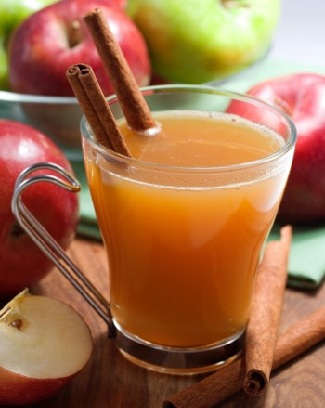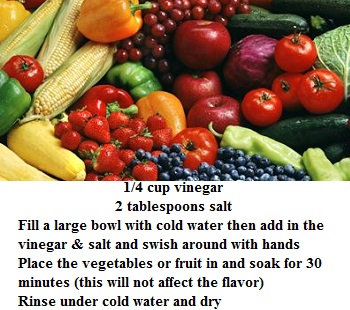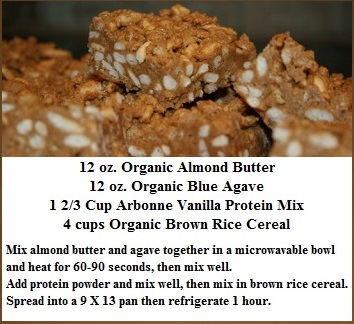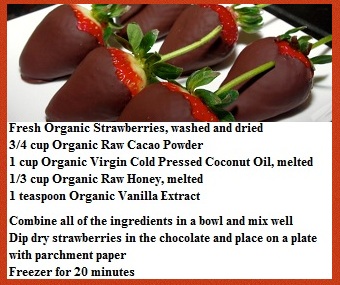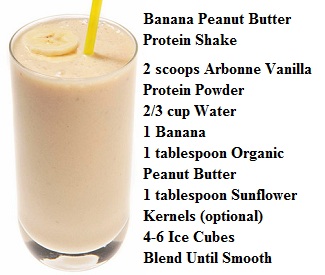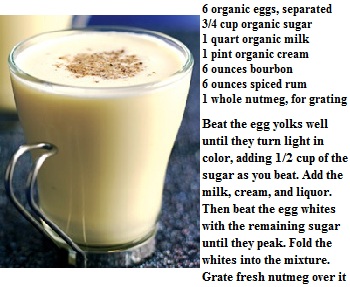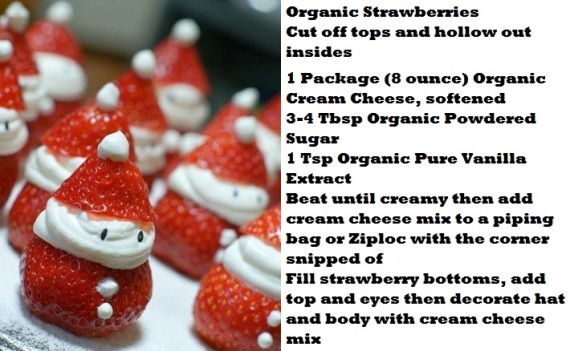Posts Tagged ‘organic’
26 Mar
Natural Dyed Easter Eggs
This Easter try something new and natural by dyeing your Easter eggs with natural coloring. Making natural dyes isn’t just a way to achieve more earthy colors, and better looking eggs but by leaving the harsh food-colorings and egg decorating kits on the shelf in the store, you are making a healthier choice for you and your family.
Have A Happy, Healthy Easter!
25 Oct
Easy Hot Apple Cider
12 or so small-to-medium-sized organic apples, assorted
1 organic orange
1/2 cup organic brown sugar
4 cinnamon sticks
1 whole nutmeg
1 Tbsp. whole cloves
1 tsp. whole allspice (optional)
water to cover
1) Wash apples and the orange, and then roughly cut into quarters. (Don’t worry about removing peels, seeds, or stems.) Place in a large stock pot.
2) Add sugar, cinnamon sticks, nutmeg, cloves and allspice. Then cover with water, filling the pot until it is nearly full (about 2 inches of space at the top of my pot). Bring to a boil and boil uncovered for at least an hour, stirring occasionally. Then cover and reduce to a simmer, and allow juice to simmer for at least another two hours.
3) Periodically during the three hours, use a potato masher (or tongs, or you could just use the side of a spoon) to begin mashing the apple and orange slices once they are soft. Add more sugar or spices to your taste.
4) When cider is ready allow to cool then strain apple and orange pieces and whole spices into a clean pitcher or pot (you can strain everything through a cheesecloth and twist and squeeze to get every last drop).
5) Serve hot, and garnish with a cinnamon stick. Store in the refrigerator and reheat as desired.
13 May
Arbonne Blueberry Smoothie
11 Mar
Cleanse & Detox Green Smoothie
2 scoops Arbonne Vanilla Protein Powder (20 grams of vegan protein, plus 20 essential vitamins and minerals)
1 Organic Apple, cored (Wash away harmful toxins in the body)
1 Organic Lemon, juiced (This citrus fruit helps boosts the digestive tract)
1 Cup Organic Kale (Chlorophyll kick starts the digestive tract by ridding the body of pesticides and environmental toxins)
1 Stalk Organic Celery (Used as a diuretic for centuries and thought to be an excellent blood cleanser)
1 Teaspoon Flax Seed Oil (Great source of Omega-3’s and ridding the body of harmful toxins)
1 Cup Arbonne Detox Tea, chilled (Boost digestive tract and flush out harmful toxins)
Add all the above ingredients to a blender and blend until smooth then pour over ice.
6 Mar
Healthy St. Patrick’s Day Green Salad
1 Organic Avocado, diced
1 Organic Green Apple, sliced thin
1 Organic Lime, squeezed
2 Organic Kiwis, sliced into thin rounds
2 Tablespoons Raw Organic Pistachios
2 Fresh Organic Mint Sprigs, remove and chop leaves
1 Tablespoons Organic Blue Agave
Fresh Organic Mint for Garnish
Add all ingredients to a large bowl and toss well with spoon.
Serve in small bowls and garnish with fresh mint leaves.
15 Jan
Homemade Dark Chocolate Covered Strawberries
Benefits of Dark Chocolate… Raw dark chocolate, also known as raw organic cacao is essentially cold-pressed cacao beans. As unprocessed chocolate, cacao is available most commonly as cocoa powder or organic raw chocolate nibs. The difference between healthy dark chocolate and regular dark chocolate is that raw chocolate has not been heated. Cacao has the highest antioxidant content on a per-serving basis. Since raw cacao is a rich source of antioxidant flavonoids it promotes cardiovascular health and protect against toxins. The antioxidant flavonoids in raw cacao can help improve circulation, regulate heartbeat and blood pressure. Additionally, cacao helps the body repair itself and resist free-radical toxins.
So for Valentine’s Day this year, make that someone special something chocolate and healthy
17 May
Do You Eat Foods High In Antioxidants?
Here is the “Top 20 Foods High in Antioxidants”, voted by The USDA… tested over 100 foods from all categories and developed an authoritative list of the Top 20:
Foods high in antioxidants usually have health benefits such as good amounts of fiber and vitamins. Although the report does not say anything about eating organic fruits and vegetables, I feel in order to get the most health benefits, you should. The main thing to remember is to reach for a variety of fruits and vegetables in the darkest colors possible, such as reds and purples, which seem to carry the highest levels of antioxidants. It is important to not just eat the same foods every day, since the variety of foods will help how they are absorbed and used by the body. Also, make sure to keep the skin or peel on, especially on apples and potatoes, to get the most antioxidant value.
4 May
Do You Have An Organic Herb Garden?
Basil – attractive annual, about 18 inches tall with light-green, fairly broad leaves. The flowers are small, white, and appear in spikes. There are several species of cultivated basil, one having purple leaves.
- Basil grows easily from seed planted after all danger of frost has passed. Pinch stems to promote bushy, compact growth. Avoid lush growth as it may reduce the flavor.
- Green leaves can be picked about 6 weeks following planting. It is best to cut leaves for drying just before flowers open.
- Spicy-scented basil leaves are one of the most popular of all herbs used in cooking. Cooks favor basil for tomato dishes in either fresh or dried form.
Chives – small, dainty, onion-like plants that grow in clumps reaching about 10 inches in height. They are a hardy perennial with decorative, light purple flowers.
- Chives demand little care other than dividing when they become overcrowded. They are easily propagated by division or from seed and make attractive border plants.
- Cut fresh leaves for use as they grow.
- Chives are used to impart a delicious, subtle, onion-like flavor to foods.
Dill – popular annual, has bluish-green stems that contrast with finely divided, yellow-green, plume-like leaves and yellowish flowers. Dill grows about 2 to 3 feet high.
- Dill is easily grown from seed sown in the garden in spring after all danger of frost has passed. Sow the seed where you want it to grow as it is difficult to transplant. Stake tall plants.
- For best results, pick leaves just as flowers open. Pick seeds when they are flat and brown.
- Both the leaves and seeds of dill are popular for flavoring pickles, sauerkraut, and beet dishes. It can be combined with garlic and pepper to produce a highly flavored Mediterranean or East European pork roast (often cooked over a spit outdoors).
Marjoram – usually grown as an annual, is one of the most fragrant and popular of all herbs. Its growth habit is low and spreading, and it reaches a height of about 8 to 12 inches. It has small, oval, gray-green leaves that are velvety to the touch.
- This plant can be easily grown from seed or cuttings. In colder climates, it is best treated as an annual or kept overwinter as a pot plant. Its color makes it an attractive border plant.
- Sweet marjoram leaves can be used anytime. Cut the leafy stems at flowering and dry for future use.
- Sweet marjoram leaves, fresh or dried, can be used as a flavoring in cooking.
Oregano – also called “wild marjoram,” is a hardy perennial that has sprawling stems which can grow to 2 feet tall. This plant is much coarser than sweet marjoram and smells more like thyme. It has small pink or white flowers.
- Oregano grows well in poor soil and can be propagated by seed or division. Thin plants 10 to 12 inches apart. Stimulate foliage by cutting back flowers. Replant when plants become woody in 3 to 4 years.
- Use fresh leaves as needed. Preserve leaves by drying.
- Oregano leaves are used extensively as a flavoring on pizza. Sprinkle leaves over lamb or steak rubbed with lemon juice. Add to other Italian-type sauces.
Parsley– a hardy biennial that is usually treated as an annual. It is popular because of its much-divided, sometimes curly leaves which have a characteristic flavor and smell.
- Parsley grows best in moist, well-drained soil, with full sun.
- Cut parsley when the leaves are of suitable size. Leaves can be used fresh or dried.
- Parsley is one of the most familiar of all herbs and is used for both garnishing and flavoring. It is relatively high in vitamins A and C and iron.
Rosemary – a hardy evergreen shrub in areas where winter temperatures stay above 5oF (-15oC). In the Northeast, however, this perennial should be taken indoors and kept as a pot plant during winter. The narrow leaves have a leather-like feel and a spicy, resinous fragrance.
- Rosemary grows best in well-drained, sunny locations in lime-rich soil. It can be propagated by cuttings or grown from seed. Pinch the tips to direct growth.
- Use fresh leaves as needed.
- Rosemary is a popular flavoring for meats and dressings or as a garnish on large roasts.
Sage – a woody, hardy perennial plant with oblong, wooly, gray-green leaves that are lighter underneath and darker on top. Sage grows 2 to 3 feet or more in height and has a tendency to sprawl.
- Start from seed or cuttings. A slow starter, sow seed indoors and transplant. Plant sage where it will receive full sun. Space plants 2 to 2 1/2 feet apart. Plants eventually become woody and should be renewed every 3 to 4 years.
- Pick the leaves before or at blooming. Cut back the stems after blooming.
- This aromatic and slightly bitter herb is noted for its use in stuffings for poultry, rabbit, pork, and baked fish. It also can be used in sausage or meat loaves.
Tarragon – an herbaceous perennial that grows to about 2 feet tall. It has multi-branched growth with narrow, somewhat twisted, green leaves.
- Tarragon will grow in full sun but seems to do better in semishade. It can be propagated from root cuttings or by division. It needs protection in winter in cold climates. Make new plantings every 3 to 4 years.
- It is best to use fresh young leaves and stem tips. Flavor is lost when tarragon is dried.
- Tarragon leaves have a distinctive flavor similar to anise and are used in salads, marinades, and sauces. Leaves yield flavor to vinegar when steeped.
Thyme – a low-growing, wiry-stemmed perennial that reaches about 6 to 10 inches in height. The stems are stiff and woody and leaves are small, oval, and gray-green in color. The lilac flowers are borne in small clusters and the leaves are very aromatic.
- This plant grows best in light, well-drained soil. Thin plants 8 to 12 inches apart. It is best to renew the plants every few years. Propagate with cuttings, divisions, or by direct seeding. Thyme is an attractive edging plant or a spreading plant among and over rocks.
- Cut leafy tops and flower clusters when first blossoms open and dry.
- Thyme is widely used as a seasoning. It goes well in gumbos, bouillabaisse, clam chowder, poultry stuffings, and slow-cooking beef dishes.
27 Apr
Need Some Great Protein Bar Recipes?
Here are 3 great and easy to make recipes using Arbonne Essentials Protein Shake Mix. (Key Ingredients: Vegan Protein Blend, Coenzyme Q10, Alfalfa, Ginseng, Flax Seed)
8 Oz. Fat Free Cream Cheese
1 Cup Arbonne Chocolate Protein Mix
3 Cups Whole Oats
1/2 Cup Truvia
Dash of Cinnamon (to taste)
1. Combine truvia, cream cheese, protein mix, and cinnamon in a bowl and mix with an electric mixer on high until its smooth.
2. Add the oats and mix with the mixer until you have a fairly homogeneous mixture.
Note if it is too thick add a 1/4 cup of milk or water
3. Spray an 8×8 pan with non-stick cooking spray. Spread the mixture in the pan. Sprinkle some additional truvia on top (optional) and place in the fridge for an hour.
Nutritional Information Per Serving: 10
154 calories, 17.8 g carbohydrate, 15 g protein, 1.8 g fat
******************************************************************************
5 Tablespoons Organic Peanut Butter (chunky or smooth)
1/2 Cup Oatmeal or Whole Grain Hot Cereal (uncooked)
1/2 Cup Oat Flour (double the dry oats if you do not have oat flour)
1 1/2 Cups Arbonne Chocolate Protein Mix
1 Teaspoon Vanilla
2 Tablespoons Flax Seeds (optional)
1 Cup Non-fat Dry Milk
1/2 Cup Water (you may need to add more)
Modifications: Use vanilla protein mix and replace 1/4 cup of the oat flour with a variety of nuts, seeds, or dried berries.
1. Combine dry ingredients in a medium size bowl and mix well.
2. Add peanut butter and mix – the mixture will be crumbly and dry.
3. Add water & vanilla.
4. Using a wooden spoon or rubber spatula, mix everything until a dough forms. The dough will be sticky.
5. Spray an 8×8 baking dish with non-stick cooking spray. Spread dough into pan using a clean wooden spoon or spatula that has been sprayed with non-stick cooking spray.
6. Refrigerate a few hours (or freeze for an hour) and cut into 9 squares. Wrap bars individually in plastic wrap or store in covered container between sheets of wax paper and keep in the fridge.
Nutritional Information Per Serving: 9
197 calories, 21 g protein, 7.2 g fat (8% saturated), 13.7 g carbohydrate, 1.6 g fiber
****************************************************************************
2 Cups Organic Peanut or Almond Butter
1 ¾ Cup Honey
2 ¼ Cup Arbonne Vanilla or Chocolate Protein Mix
3 Cups Old Fashioned Oatmeal
1 Tablespoon Cinnamon
½ Cup Almond Slivers
1. Add peanut or almond butter and honey in a microwave safe bowl. Microwave it for 1 minute and then stir.
2. In another bowl add protein mix, oatmeal, cinnamon and almond slivers. Stir it all together.
3. Add the peanut or almond butter and honey mixture to the protein mix and oatmeal mixture. It is going to be very thick.
4. Press the mixture into a 9 x 13 inch pan and refrigerate for an hour. Once they are good and cold, cut them into bars. Recipe makes 28 bars depending on how big you want them. Wrap each bar in plastic wrap and keep it in the fridge. Can be frozen – they freeze well.
Nutritional Information Per Serving: 28
225 calories, 12.5 g protein, 10.7 g fat, 23.1 g carbohydrate, 2.0 g fiber (This is the info for the Peanut Butter Protein Bars – I think these are the same for both)
10 Apr
Did You Know What The Stickers You Find On Your Produce Mean?
The PLU (Price look-up) code is usually a four-digit number, currently in the 3000 – 4999 range, identifying the type of bulk produce, including the variety.
These stickers you will find on produce such as fruit, vegetables, herbs, and nuts, actually tell you quite a bit about the produce:
* If there are only 4 numbers that means they were conventionally grown.
* If there are 5 numbers starting with number 8 that means they are genetically modified (GMO). The industry soon realized that we weren’t buying the produce with the number 8 and quickly decided to remove the number 8 as a part of their code, making it hard to distinguish genetically modified produce. Adherence to the IFPS’s PLU standards is voluntary, including the decision to label produce as genetically modified.
* If there are 5 numbers starting with 9 that means they were organically grown (no pesticides or GMOs).
If you have some time and I mean lots of time, you can read the Global and Regional PLU List that will tell you all about what the first 4 numbers mean.
29 Mar
Is Buying Organic Worth The Cost?
My position on organic foods is quite simple: If I had a Dr. Oz or Oprah food budget, I’d buy everything organic. It’s true that organic foods are not purchased exclusively by the very rich or else it wouldn’t be a billion dollar industry. There are lots of regular people with regular incomes who have made the lifestyle choice of buying organic foods. I have made that choice, whenever possible and affordable, and some items that I’ve been buying organic for a decade now like milk, yogurt, eggs and butter are not cheap by any standard but I feel are worth it for my health. When it comes to produce, if there is a sale on organic products, I’ll jump at the occasion and there are certain conventional products, like berries, I will no longer eat if I cannot buy them organic. If I could only buy organic meats I would, but most are too expensive and hard to find so I do buy grain feed meats because they are affordable and they can easily be purchased at most grocery stores. No matter your goal when buying organic, there are ways to save money.
Libba Letton, spokesperson for Whole Foods Market, suggests the following:
• Buy your items in season. Even organic food is going to be priced cheaper when it’s in season, and this advice applies whether you’re buying conventionally or organically grown produce.
• Talk to the staff in the produce department of your local grocery store. Ask where the produce comes from, if it’s in season and if you can sample it. Make sure you’re spending on something worth it.
• Buy things in bulk. At Whole Foods, customers who buy in volume are offered up to a 10 percent discount.
• Buy only as much as you need. Food bought in large portions often goes to waste. If your store offers a bulk bin option, you can take as much or as little as you need which also means less packaging.
• Make your grocery list and stick to it.
• Compare organic-to-organic prices. In stores where there are less organic items, those items tend to be much more expensive.
Here are Dr. Oz’s 3 simple rules for when you should spend your green to go green and when to save your cash with conventional foods.
1. Thin Skins
Go organic: apples, peaches, strawberries, raspberries, blueberries, blackberries, cherries, grapes, pears, nectarines, peppers, celery, potatoes, and carrots
Save your cash: avocados, eggplants, pineapples, bananas, corn, kiwi, mangoes, papaya, sweet peas, oranges, grapefruit, and squash
2. Leafy Greens
Go organic: all lettuces and greens such as kale, collards, mustard, swiss chard, and spinach
Save your cash: broccoli, cabbage, asparagus, cauliflower, eggplant, melons, and sweet potatoes
3. Milk Products
Go organic: milk, yogurt, and cheese
Save your cash: fish and other seafood (USDA has no guidelines for certifying organic seafood)
12 Jun
Are household spices great natural healers?
 Organic spices can be used as a safe and natural alternative to the synthetic drugs found in your medicine cabinet. Spices can be used to treat problems ranging from headaches, diarrhea, and gas to high blood pressure and acute infections.
Organic spices can be used as a safe and natural alternative to the synthetic drugs found in your medicine cabinet. Spices can be used to treat problems ranging from headaches, diarrhea, and gas to high blood pressure and acute infections.
Below are 25 common household spices that are great natural healers!
Allspice
Great at relieving flatulence and dyspeptic pain, helps with nervous exhaustion, gas, and diarrhea. It may be applied as a compress in cases of rheumatism and neuralgia
Anise
Excellent for improving memory, colds, flu, cough, bronchitis, sinusitis, gas, colic, tension, lactation (not pregnancy!), eye brightener, fresh breath. Anise is very useful for breaking up mucus and is used for hard, dry coughs where expectoration is difficult. A tea is made by adding a cup of boiled water to three teaspoons of crushed seeds, steeping for 20-minutes. This may be used to stimulate the productions of mother’s milk. The seeds may be smoked or added to a cough syrup formula. It is also used as a stimulant and carminative to treat flatulence and colic, taken as a tea. Added to laxative formulas, it will reduce cramping of the bowels. For hacking coughs add 7 teaspoons of Anise Seeds to 1 quart of boiling water and then simmer down to 1 1/2 pints. Strain and add 4 teaspoons each of honey and glycerin. Take 2 tsp. of this syrup every few hours to relieve the cough. To improve memory, take 2 tablespoons, 3 times a day.
Basil
A basil tea is good for lowering blood sugar levels and blood pressure, relieves colds, fever, congestion, joint pain, analgesic, anti-inflammatory. Externally applied to insect bites, skin infections. A Basil tea is good to use for indigestion, fevers, colds, flu, kidney and bladder troubles, headaches, cramps, nausea, vomiting, constipation and nervous conditions. A tea made of one heaping tablespoon to one pint of water simmered for 20-minutes with 3 crushed black peppercorns per cup will be effective for most fevers. Traditional uses: coughs, colds, fevers, headaches, lung problems, abdominal distention, absorption, arthritis, memory, nasal congestion, nerve tissue strengthening, clears the lungs, heart tonic, oxygenates the body, cleanses and clears the brain and nerves, relieves depression and the effects of poisons, difficult urination, prevents the accumulation of fat in the body (especialy for women after menopause), obstinate skin diseases, arthritis, rheumatism, first stages of many cancers, builds the immune system. Basil contains the trace mineral copper (organic form), needed to absorb iron.
Bay Leaf
Internally good to stimulate appetite, promote digestion, relieve colic and flatulence. Externally good for dandruff, boosting hair growth, rheumatism, sprains, scabies, and bruises. Also externally, can be applied as a poultice on the chest with a cloth covering to relieve bronchitis and coughs. An oil infused with Bay Leaves can be applied with great benefit to rheumatic and arthritic aches and pains as well as to swellings and sprains.
Pepper (black)
Pepper is an excellent remedy one can take at the first sign of most diseases. Yogis consider Pepper to be one of nature’s most perfect foods and useful not only to cure disease but also as a preventive, taking a dose of seven peppercorns, ground, and mixed with honey each morning. The mixture of pepper and honey is useful to overcome cold mucous diseases and sore throats. When treating acute diseases, it may be used three to four times a day. Useful for asthma, boils, colic, cough, diarrhea, fever, gas, hemorrhoids, indigestion, chronic rheumatism, obesity, phlegm, sinus congestion, skin diseases, sore throat, and worms.
Cardomom
Cardamom is often used to treat indigestion and gas. It warms the body and is good for darrhea, colic and headaches. It is an important ingredient in Chai tea, an Indian spice valued for its warm, stimulating effects. To make this tea, mix one teaspoon of ginger, add seven peppercorns, a cinnamon stick, five cloves, and 15 cardamom seeds and heat in one pint of water, simmering for 10-minutes. Then add one-half cup of milk and simmer for another 10-minutes. Add a sprinkle of nutmeg and a few drops of vanilla extract. Drink one cup of the tea, sweetened with honey, twice per day or as needed for warmth.
Cayenne (red) Pepper
Considered a superior crisis herb, useful as a first aid remedy for most conditions. Taken as a daily tonic, one-quarter teaspoon three times daily, it is beneficial for the heart and circulation, preventing heart attack, strokes, colds, flu, dimished vitality, headaches, indidgestion, depression, and arthritis. Cayenne is hot, but it not harmful. It may be difficult to swallow for a beginning user. Cayenne powder can be rubbed on toothaches, swellings, and inflammations. A remedy for arthritis is to rub a little Cayenne over the inflamed joint and wrap a red flannel around it to remain throughout the night. The pain is usually relieved by morning. A little Cayenne on a banana skin placed on the skin with a bandage will remarkably draw out any foreign object (splinters, etc) embedded in the flesh.
Cilantro
Used traditionally for digestive and gastric complaints as well as for coughs, chest pains, bladder complaints, leprosy rash, fever, dysentery, externally for headaches, oral and pharyngeal disorders, halitosis, and post-partal complications. Can be applied externally for rheumatism and painful joints. It improves the flavor of other medicinal preparations. Once thought to be an aphrodisiac. Chinese herbalists use Cilantro to remove unpleasant odors occurring in the genital areas of men and women, as well as bad breath.
Cinnamon
Very helpful for digestive problems especially when accompanied by gas and cramping, diarrhea, vomiting. Also used to treat colds, flu, arthritis and rheumatism. Medicinally it is used to warm the organs to treat chronic diarrhea, cramps, heart and abdominal pain. It is effectively used as a tincture given every fifteen minutes or so to stop bleeding from the uterus. Simmered in milk and taken with a little honey, Cinnamon is very effective for indigestion and gas, diarrhea, and dysentery. Not for the pregnant. Traditional uses: backaches, bronchitis, colds, congestion, diarrhea, dysentery, edema, flu, gas, headaches, hiccup, indigestion, liver problems, menorrhagia, menstrual pain, melancholy, muscle tension, nausea, pain of the waist and knees, palpitations, toothache, vomiting.
Cloves
Internally good for pain relief, nausea, vomiting, digestive problems, antifungal, antibacterial, hiccups. Cloves will kill intestinal parasites and act as an antimicrobial agent against fungi and bacteria. Externally good for insect bites, myalgia, and rheumatism. May be chewed for toothaches. Eating cloves is said to be an aphrodisiac. To make an infusion, use 1 teaspoon of powdered herb per cup of boiling water, steep 10-20 minutes and drink up to 3 cups a day.
Coriander Seed
Coriander Seeds are added to hot stimulating foods to impart a balanced coolness. Steeped in tea, it is useful to relieve fevers (a small amount of black pepper may be added to stimulate its action). Use 2 teaspoons of crushed seeds in a cup of boiled water and steep for 20-minutes. Before the invention of toothpaste, coriander seeds were chewed as a breath sweetener. Coriander is added to laxative formulas to help prevent cramping.
Curry
A blend of ginger, turmeric, cardamom and other spices that have been shown to increase metabolism, help breathing, and reduce cholesterol.
Garlic
Useful for asthma, bronchitis, circulation, colitis, coughs, gas, high blood pressure, intestinal infections, lungs, parasitic diarrhea, warts, worms, anti-fungal, arthritis, blood purifier, cancer, cold, fever, flu, infections, detox liver, mucus, prostate, toothache, tumors, whooping cough, and yeast infections.
Ginger
Good for bronchitis, colds, muscle and menstrual cramps, energy, sore throat, circulation, cough, digestion, flu. Externally, Ginger is applied as a fomentation for the treatment of pain, inflammation, and stiff joints. Simmer one ounce of dried Ginger Root in two quarts of water for ten minutes. Strain and soak a cloth in the water and apply to the affected area. Keep changing the cloth to keep a constant warm temperature on the skin. The skin should become red as the circulation increased. For children and adults with bronchial coughs: mix Ginger Root powder with a non-petroleum jelly and rub on their chest to help loosen coughs and expel mucous. Works great!
Lemongrass
Useful for menstruation disorders, congestive and neuralgic forms of dysmenorrhea, vomiting, diarrhea, colic, flatulence, muscle spasms, fever, catarrh. For fevers, combine with ginger, sugar, and cinnamon. Good for children’s digestive system. Externally, great for lumbago, chronic rheumatism, neuralgia, ringworm, lice, athletes foot, scabies, and sprains. Mix with pure coconut oil to apply as a liniment.
Marjoram
A tea made from Marjoram is used for an upset stomach, headache, colic, and a variety of nervous complaints. It can be used for cramps and nausea associated with menstruation and for severe cases of abdominal cramps. It is also considered helpful for seasickness. It can be added to the bath to promote a calming effect and to relieve insomnia. Marjoram is applied as a fomentation to painful swellings and rheumatic joints and in salves to stimulate the circulation.
Mustard
Internally, a teaspoon full of crushed seeds in warm water acts as a mild laxative and blood purifier. Externally, a Mustard infused oil is used to stimulate local circulation. A Mustard plaster is used for aches, sprains, spasms, and cold areas needing ciruculation. It should not be used on tender, sensitive areas and if it seems to strong, the Mustard may be diluted with a little rye flour.
Nutmeg
A small amount of Nutmeg, about the size of a pea, can be taken once daily over a long period to relieve chronic nervous disorders and heart problems. Internally good for diarrhea, dysentery, gastroenteritis, vomiting, bloating, indigestion, colic. Externally good for eczema, rheumatic and abdominal pain.
Oregano
Oregano helps to settle flatulence and stimulates the flow of bile, useful promoter of menstruation. Great for headaches. It is often used in the treatment of colds and flu also, the infusion is used in coughs and whooping cough. Use as a mouthwash for inflammations of the mouth and throat. It may also be used externally for infected cuts and wounds and may be applied as a hot fomentation to relieve painful swellings and rheumatism, as well as for colic. A lotion may be made which will soothe stings and bites. As with basil, it has been suggested that eating a lot of oregano can help repel mosquitoes. Oregano has many of the medicinal attributes of the other marjorams, but it also contains further essential oils which make it much more antiseptic in action, both internally and externally.
Paprika
Good source of Vitamin C. Acts as antioxidant. Mild form of cayenne pepper which serves as a carrier for other nutrients.
Parsley
Internally used as a diuretic, to relax spasms, reduce inflammation, clear toxins in the body, inhibit tumor growth, menstrual complaints, urinary tract problems, gas, dyspepsia, rheumatism, arthritis, anemia, anorexia, colic, indigestion, lactation. Externally relieves itching.
Rosemary
Commonly used as an aspirin substitute for headaches. Internally good for improving digestion, gas, rheumatism, circulatory problems, headaches, nervous complaints, antifungal, antioxidant, antibacterial. Good as a mouthwash for gums and sore throat. Externally use in baldness shampoos, increases circulation, scalp stimulation, and dandruff.
Sage
Internally good for indigestion, gas, reduce excessive lactation, night sweats-especially menopausal, excessive salivation, profuse perspiration, anxiety, depression, female sterility, and menopausal problems. It should not be used for more than a week, but during this period, the tea may be taken up to 3 times per day. Externally good for insect bites, throat mouth and gum infections, vaginal discharge, combats greasy and oily hair and scalp and helpful with acne.
Thyme
A tea made with thyme is commonly used for bronchial problems such as acute bronchitis, whooping cough and laryngitis. It is aso beneficail for the treatment of diarrhea, chronic gastritis, and lack of appetite. Uses: alcoholism, headache, mucus, stomach, worms, parasites, hangover, infection, respiratory, stomach cramps. Externally, its antiseptic properties make it a useful mouthwash and cleansing wash for the skin. It will destroy fungal infections such as athlete’s foot and skin parasites such as scabies, crabs and lice. For those purposes, a tincture made from 4 ounces of Thyme to a pint of alcohol is used. It is said that Thyme is to the trachea and bronchitis what peppermint is to the intestines and stomach. It contains an aromatic oil called thymol that is responsible for many of its excellent properties.
Turmeric
Makes an excellent arthritis tea! Strong anti-inflammatory, blood purifier, hepatitis, inflammatory bowel diseases, bruises, colic, ulcers, hemorrhages, yeast infections, antiseptic. It can be used internally and externally to heal wounds, relieve pains in the limbs, break up congestion and as a restorative after the loss of blood from childbirth. Turmeric Arthritis Tea Recipe: 1/2 teaspoon Turmeric, 3 cardamom pods (optional), 1/4 cup water. Simmer 5 to 7 minutes, then add 1 cup of milk, 2 tablespoons almond oil (cold pressed). Bring just to the boiling point (but do not boil). Add honey or Agave Nectar to taste. Sip slowly as a hot tea.
13 Apr
Toxins – Why are babies and children more vulnerable?
Babies & children are exposed to higher levels of environmental toxins than adults. Children eat more food, drink more fluids, breathe more air, and have more surface skin compared to their body weight than adults. This causes a higher exposure to pollutants and contaminants in the air, their food, and care products.
Their bodies are more rapidly growing and developing, so chemicals that can harm development can do maximum damage at this critical time. Children also play on the floor, where allergens, such as dust, and heavier-than-air chemicals settle and collect.
Then there’s natural behavior: Putting everything in the mouth is a crucial part of normal development, the way a baby learns about the world. Many times, these toxic chemicals will cross the barrier from mother to child” — for instance, the main ingredient in deodorant ends up in breast milk.
Facts:
• The cosmetics industry was de-regulated in 1938 allowing personal care product companies to use ANY raw material in their products without FDA approval.
• Many companies commonly use toxic chemicals & pesticides in products because they are cheaper to manufacture.
• Many US products have been banned in Europe due to the ingredients they contain.
• Johnson & Johnson has been told to either add a warning label to their products or take the word “Baby” off of their Lotion if they wish to continue product sales in India.
• 70% of all personal care products contain toxins or cancer causing agents.
• 60% of what we put on our skin is absorbed into the body.
• The FDA does not require studies on long-term health risks, only short-term irritancy tests (such as animal testing).
How to protect yourself/ your family:
1. Read ingredient labels
• Many companies market “natural” product lines containing lavender, chamomile, etc. however many also contain harmful ingredients.
• Don’t assume what you are buying at a “natural food store” is free of chemicals.
• Be aware of long words that you cannot pronounce that have the words “from coconut oil” in parenthesis. Natural ingredients that are broken down chemically are no longer natural.
• Look for the words “cold-pressed” or “organic” on the label
• Find out if the ingredients are organic. Very high toxicity levels of pesticides become concentrated in liquids extracted from plants.
2. Use Certified Vegan Products when available to reduce overall exposure
3. Educate yourself – Some sources for more information:
• The Environmental Working Group – a government watchdog organization that tests many common household products and publishes their safety profiles online at (http://www.cosmeticsdatabase.com). Here you can:
a. Search product categories and sort them based on toxic concerns
(i.e., “Baby shampoo” search shows products of most concern to least concern)
b. Search specific products and companies for toxic ingredient information
(Aveeno, Johnson & Johnson, Gerber, etc).
c. Research ingredients for specific health concerns
(propylene glycol, polysorbate-60)
• Healthy Child Healthy World (http://healthychild.org)
• “Is this your Child’s World?” by Doris J. Rapp, M.D.
• “Home Safe Home” by Debra Lynn Dadd
• Natural News Network (http://www.naturalnews.com)
• Scorecard (http://www.scorecard.org)


